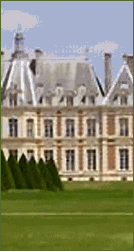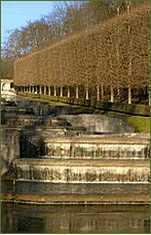|
Chateau de Sceaux is picturesquely situated on a hill around 10km
to the south of Paris and is often said to be one of the most idyllic settings such a
short distance from the City.
In the summer there is a classical music festival held at the Orangerie and also an
outdoor Opera with the chateau as a magical backdrop and being only around half an hour
from the City of Paris it can be reached easily by
the RER B and you disembark at station park Sceaux.
The chateau now holds a museum and this is completely free to enter as are the parks and
gardens. Next to the castle there is a place where you can purchase refreshments,
but what most people do is take their own food, or purchase this fresh at the local
markets held in Sceaux every Wednesday and Saturday or at the traditional local bakery.
From 1st April through to 30th September the museum opens at 10am to noon, then from 1pm
to 6pm and from 1st October to 31st March it opens at 10am to noon, then from 1pm to 5pm
except for a Tuesday and the gardens are open all day every day of the week.
History of Chateau de Sceaux
A mansion of Sceaux appears in documents as far back as the 15th century and after this a
palace was built for the Potier de Gesvres family, but little remained. Then a
Jean-Baptiste Colbert, who was King Louis XIV's minister of finance, purchased the domain
in 1670.
To design the castle Jean-Baptiste Colbert turned to some of the major royal architects
and craftsmen such as the brothers Claude and Charles Perrault, then in 1683 the Marquis
de Seignelay who was the son of Colbert and minister of the Navy, inherited Sceaux and had
the one kilometre long Grand Canal excavated.
It was actually Andre Le Notre who designed the gardens, where the main axis and two
secondary axis were laid out with such things as a formal cascade that flows down to fill
an octagonal basin.
Also, it was the architect Jules Hardouin-Mansart that built the Orangerie, which was
inaugurated by the King at a fete in 1685, but then in 1699 the Sceaux Chateau was sold to
Louis' illegitimate son, the duc du Maine, however it was his wife, Anne, Duchesse du
Maine that made it the setting for her glittering salon in the first decades of the
eighteenth century, with lots of fetes and she had the pavilion of the Ménagerie built,
but today, but unfortunately only the foundations remain.
During the French Revolution the property was confiscated and its contents sold, then
Sceaux was purchased by M Lecomte, who was a merchant of Saint-Malo and he had the castle
demolished, but the pavilion of Aurore, the Orangerie, the stables, and outbuildings were
preserved. It seems quite incredible that Lecomte disregarded the brilliance of
Andre Le Notre, who designed gardens for other famous
chateaux like Chateau de Versailles and he
had these gardens at Sceaux growing crops!
Sceaux was then inherited by the Duc de Trévise, who had married the daughter of M
Lecomte and he decided to restore the domain, park, pavillion and Orangerie. And
between the years of 1856 and 1872 the smaller chateau that we can still see today, which
was designed by the architect Augustin Theophile Quantinet and completed under the
guidance of Joseph-Michel Le Soufache.
In 1922 after the Chateau de Sceaux had been inherited by Princess de Faucigny-Cystra, she
had planned to give up Sceaux to property developers, but through the tremendous efforts
of the mayor Jean-Baptiste Bergeret de Frouville it was preserved and then opened to the
public.
Today the chateau has a public park and also as stated before contains a museum that
opened in 1937, called the Musée de l'Île-de-France,
which contains one of the largest collections of the painters of the School of Paris and
as the name suggests, is a museum dedicated to the history of the Ile de France region.
Address & Contact Details:
Chateau de Sceaux
92330
Sceaux
Ile de France
Telephone: 1 41 87 29 50
Fax: 1 41 87 29 51
|
|



